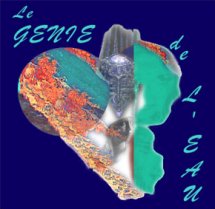WAVE RINGS
WATER INSTALLATION FOR COMMUNICATION IN PUBLIC SPACE
BY NODOKA UI
(Sound and Programming Kohji SETOH)
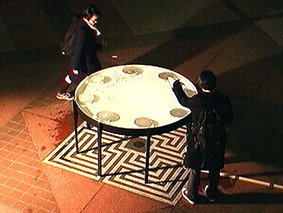
"Wave rings"
1998
Water Installation
Sound and programming Kohji SETHO
© Nodoka UI
|
|

"Wave rings"
1998
Water Installation
Sound and programming Kohji SETHO
© Nodoka UI
|
1. CONCEPT
In the past, public spaces where people gathered to fetch water, like wells and springs, were also places where people communicated with each other, exchanging information about everyday like.
Since the 17th century, new water supply systems came into widespread use and we began to have running water in each house. We stopped needing public water sources to fetch water, and people stopped gathering around them. The original function of public water sources disappeared and was replaced by an aesthetic function. Rather than being a place to meet and communicate, public water sources became objects to look at and appreciate. Thus, the relationship between people and public water spaces deteriorated.
In Japan, public water sources did not serve the same aesthetic function as those in Europe (for example, the fountains of Rome), so they gradually disappeared from the cities. However, during the Meiji period the Japanese government began importing fountains from Europe to Japanese cities, introducing a completely different aesthetic of water use. Historically, the Japanese appreciated water mostly in private spaces, such as gardens, not in public spaces. The new European ways and ideas had no historical context in Japan and so were not deeply understood, only copied. Although we now have fountains in Japanese cities, most of them have no strong connection to Japanese history, culture or community.
The installation is for people to communicate by using ripples of water and sound as pleasant media in place of language. Participants capture the original function of space around public water sources - the space for communication.

"Wave rings"
1998
Water Installation
Sound and programming Kohji SETHO
© Nodoka UI
|
|
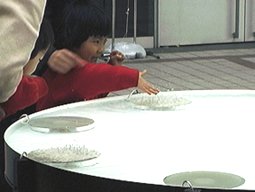
"Wave rings"
1998
Water Installation
Sound and programming Kohji SETHO
© Nodoka UI
|
2. INSTALLATION/SETTLEMENT
Imagine a pool, 150 cm in diameter, that has eight speakers, each 20 cm in diameter, submerged inside of it.
Each speaker is equidistant from one another and butted against the enclosing well of the pool. This pool is supported by eight legs, each 80 cm long. The speakers are safely ensconced in cylindrical acrylic cases, their surfaces covered and waterproofed by a very thin latex sheath.
The pool is filled with water until the top surface of each speaker is under 1 cm of water. From above, one can see that each speaker is positioned in front of each leg. Each leg has an infrared sensor attached to it, corresponding to its neighboring speaker.
When a person approaches or passes the pool, the nearest sensor to the person will trigger a speaker to make musical sound. When sound emits from the speaker, the vibration of this speaker transforms the movement of the water ; tiny columns of water flow and wave rings appear on the surface of the water.
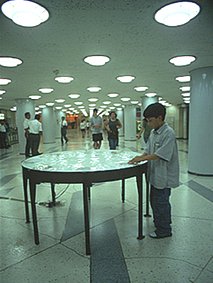
"Wave rings"
1998
Water Installation
Sound and programming Kohji SETHO
© Nodoka UI
|
3. SYSTEM
Analog signals are input from eight sensors (from A to H) and are digitized by an I-CUBE analog/digital converter. This information is sent to a Macintosh Computer in the form of MIDI data. When receiving the triggering signal from a particular sensor, the corresponding sound is sent to the speaker neighboring that sensor.
- About sensor and speaker
When one approaches the pool, the nearest sensor to the person will cause the speaker to sound and induce wave rings which will spread throughout the entire pool.
If only one person is close to the pool, sound and wave rings will emerge from only one source. But if multiple people get near and trigger the sensor at nearly the same time, many speakers will sound and a kaleidoscopic pattern of sound and water will cross and interact each other.
- Ripple of the Air = Ripple of the Water
Sound is the rippling of air. The size and character of these ripples, or vibrations, depends upon the nature of the sound's source. By conveying these ripples of air to water, the medium of water becomes a dynamic sculptural canvas where intricate and ephemeral patterns of water undulate and ring until they fade away into stillness.
Each speaker has a different sound composed for it, which produces a unique pattern of wave rings in size, shape, and frequency.
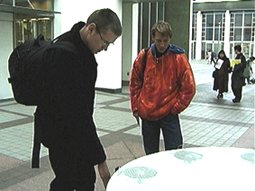
"Wave rings"
1998
Water Installation
Sound and programming Kohji SETHO
© Nodoka UI
|
- Wave Rings as a Medium of Communication
In this installation, water becomes a medium of communication, where wave rings become a kind of language between the people surrounding and interacting with the pool. The installation acts also as a catalyst for communication, the simple novelty of the curious mechanism of WAVERINGS inspires people to interact - yet beyond this, the installation's reaction to bodily movement suggests a kind of dance. The dance is a communication of the body that demands group interaction as each participant's movements will affect the surface of the water.
Participants are happily drawn into an open, communicative state of mind which they do not normally share with strangers. Furthermore, because of the range and placement of the infrared sensors, anyone in proximity to WAVERINGS is a participant, normal body movements will trigger sounds and water movement. To remain near the work entail automatic participation.
When we speak, we choose our own words to reflect our own mood and personality. The music of each speaker has its own character, " energetic ", " calm ", etc. People have the ability to identify with the character of a particular speaker and choose to speak with it.
Water can change form infinitely. In Waverings, if people continue to approach the work and if they choose to interact directly with the water by touch, the patterns will have even more variation and can serve as a richer medium with a capacity for more than the eight people the sensors provide for. With touch, rich variation and power are available to the participants.
- Water to share with others
By setting this water installation, which serves as a medium of communication, in a public space, people will begin to become conscious of and explore other public water installations. This consciousness can provide a sense of the " waterside " that existed in communities with wells and other public sources of water, which were not only a means of vital resource but also a focal point for the community.
WAVERINGS has no form without the interactions of people. The texture of the water, which is simply the conveyance of human motion and interaction, is still without the living presence of people. It is less of an experience for one person to interact with WAVERINGS alone, as it is for a group to explore their intercommunication through the flowing medium of water.
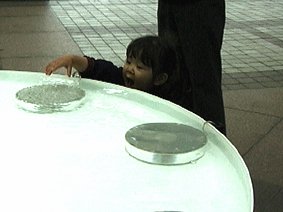
"Wave rings"
1998
Water Installation
Sound and programming Kohji SETHO
© Nodoka UI
|
|
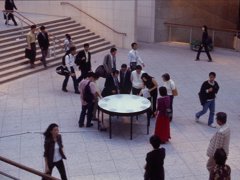
"Wave rings"
1998
Water Installation
Sound and programming Kohji SETHO
© Nodoka UI
|
Biography of Nodoka Ui
|










